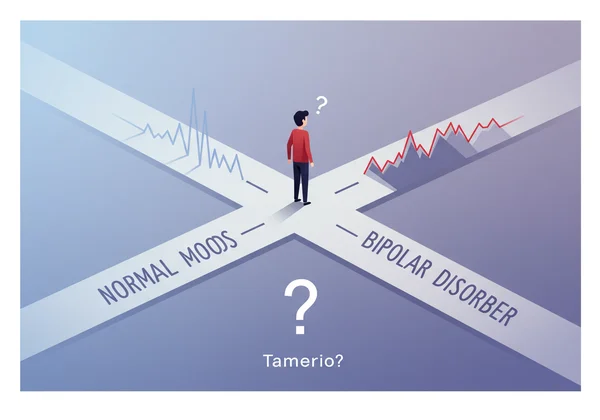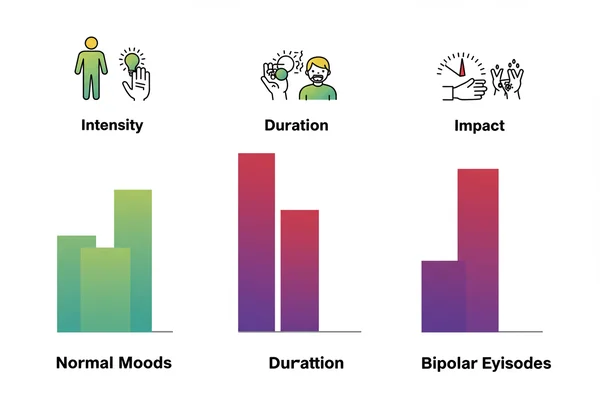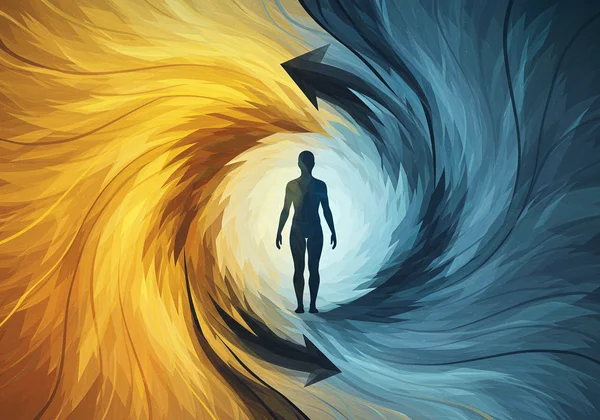Am I Bipolar? Take Our Bipolar Test to Differentiate Mood Swings & Symptoms
Feeling lost in a sea of intense emotions can be isolating and confusing. One day you might feel on top of the world, and the next, you could be struggling to get out of bed. This leads many to ask the critical question: Am I bipolar, or am I just moody? The line between normal emotional fluctuations and the distinct patterns of bipolar disorder can seem blurry, but understanding the difference is the first step toward clarity and control.
If you're trying to make sense of your emotional landscape, you are not alone. How can I test if I am bipolar? While a definitive answer requires professional evaluation, gaining knowledge is a powerful first action. This guide will help you differentiate between everyday moodiness and the specific symptoms of bipolar disorder. For a structured way to explore your own experiences, you can always get some clarity with a confidential screening tool.

Understanding Normal Mood Swings vs. Bipolar Mood Episodes
Everyone experiences shifts in their mood. A promotion at work can bring joy, while a conflict with a friend can lead to sadness. These feelings are a normal part of the human experience. However, the mood shifts associated with bipolar disorder are fundamentally different in their nature, scale, and impact on a person's life. Distinguishing between them is crucial for understanding your mental health.
What Defines "Normal" Mood Fluctuations?
Before we dive deeper, it's helpful to understand what 'normal' mood fluctuations entail. Normal mood fluctuations are typically tied to specific life events, circumstances, or even physiological factors like lack of sleep or hunger. You might feel irritable after a stressful day or elated after receiving good news.
Crucially, these moods are generally manageable. While they influence how you feel, they don't usually derail your ability to work, maintain relationships, or manage daily responsibilities. They are transient, often lasting hours or a couple of days before your emotional state returns to its usual baseline. They are the expected weather patterns of your emotional world, not extreme climatic events.
Key Differences: Intensity, Duration, and Impact
The distinction between moodiness and bipolar episodes lies in three key areas: intensity, duration, and impact. Unlike regular mood swings, bipolar episodes are distinct periods of abnormally elevated or depressed mood that represent a significant departure from your usual self.
-
Intensity: Bipolar episodes are far more intense. A "high" isn't just feeling happy; it's a period of mania or hypomania characterized by extreme energy, racing thoughts, and sometimes impulsive or risky behavior. A "low" is not just sadness; it's a major depressive episode that can involve profound hopelessness and physical exhaustion.
-
Duration: These episodes have a clear beginning and end, lasting for a sustained period—at least several days for a hypomanic episode, a week or more for a manic episode, and two weeks or more for a depressive episode.
-
Impact: This is perhaps the most critical differentiator. Bipolar episodes significantly disrupt your life. They can damage relationships, jeopardize your career, and interfere with your ability to function. Normal moodiness doesn't typically carry this level of life-altering consequence.

Recognizing Bipolar Disorder Symptoms
To truly understand if your experiences align with bipolar disorder, you must look beyond the simple idea of "mood swings" and examine the specific criteria for mood episodes. Bipolar disorder symptoms are categorized into two main types: manic/hypomanic episodes (the "highs") and depressive episodes (the "lows"). An individual may experience one, the other, or a mix of both.
The Role of Manic and Hypomanic Episodes
Many people who have been misdiagnosed with depression often overlook the significance of their "high" periods. Recognizing manic and hypomanic episodes is essential for an accurate understanding. Hypomania is a less severe form of mania, but both represent a distinct change in mood and functioning.
During a manic or hypomanic episode, you might experience:
- An abnormally elevated, expansive, or irritable mood.
- Inflated self-esteem or grandiosity.
- A significantly decreased need for sleep (e.g., feeling rested after only 3 hours).
- Being more talkative than usual or feeling pressure to keep talking.
- Racing thoughts or a flight of ideas.
- Extreme distractibility.
- An increase in goal-directed activity or restless energy.
- Engaging in activities with a high potential for painful consequences, such as spending sprees, foolish business investments, or sexual indiscretions.
Understanding Bipolar Depression
The depressive side of bipolar disorder can look very similar to major depressive disorder, which is why misdiagnosis is common. However, bipolar depression exists as part of a cycle that also includes manic or hypomanic episodes. For those who suspect their previous depression diagnosis was incomplete, recognizing this pattern is key. If you've been treated for depression without success, it's worth exploring if highs were part of your experience. An online bipolar test can be a useful tool to screen for both poles of experience.
Symptoms of a bipolar depressive episode include:
-
Persistent feelings of sadness, emptiness, or hopelessness.
-
Loss of interest or pleasure in almost all activities.
-
Significant weight loss or gain, or a decrease/increase in appetite.
-
Insomnia or sleeping too much.
-
Fatigue or loss of energy.
-
Feelings of worthlessness or excessive guilt.
-
Difficulty concentrating or making decisions.
-
Recurrent thoughts of death or suicide.

When to Seek Professional Guidance for Your Moods
If this information resonates with you, and you see your own experiences reflected in the descriptions of bipolar episodes, the next step is to seek professional guidance. Self-education is empowering, but it cannot replace a formal diagnosis from a qualified healthcare provider, such as a psychiatrist or psychologist. Taking this step is a sign of strength and self-awareness.
The Value of Self-Assessment Tools
Before you see a doctor, organizing your thoughts can feel overwhelming. This is where self-assessment tools become incredibly valuable. A confidential screening, like the one offered on our site, can help you structure your experiences. Based on established clinical criteria like the Mood Disorder Questionnaire (MDQ), it guides you through questions about your moods, energy levels, and behaviors.
This is not a diagnosis. Rather, it is a safe, private, and informative first step. It provides you with a summary of your patterns that can make the conversation with a professional much more focused and productive. You can even opt for a personalized AI report for deeper insights. Are you ready to see what your patterns might indicate? You can take a free screening right now.

Preparing for a Conversation with a Doctor
Walking into a doctor's office to discuss your mental health can be intimidating. Preparing for a conversation beforehand can ease your anxiety and ensure you get the most out of your appointment. Consider bringing the following:
- A list of your key symptoms, including both the highs and the lows.
- Notes on how long these moods last and how they impact your life.
- Any questions you have about bipolar disorder, treatment, or the diagnostic process.
- The results from a confidential bipolar assessment test, which can serve as an excellent conversation starter.
Your Path to Clarity: Taking the Next Step
Differentiating between normal moodiness and the symptoms of bipolar disorder is a journey of self-discovery and courage. It involves recognizing that bipolar disorder is not about being "moody" but about experiencing distinct, sustained episodes of mania/hypomania and depression that significantly affect your life. Understanding this distinction empowers you to seek the right kind of help.
Your path to clarity begins with a single step. If you're ready to better understand your emotional patterns in a structured, confidential way, we invite you to use our tool. It’s free, based on scientific standards, and designed to give you the initial insights you need to move forward.
Start Your Bipolar Test today and take control of your mental health journey. We encourage you to share your thoughts or questions in the comments below—creating a community of support is vital.
Frequently Asked Questions About Bipolar & Mood Swings
What are 5 common signs of bipolar disorder?
While experiences vary, five common signs include: 1) A distinct period of elevated mood and energy (mania or hypomania). 2) A distinct period of profound sadness and low energy (depression). 3) Clear, cyclical shifts between these highs and lows. 4) Changes in sleep patterns, energy levels, and thought speed that accompany mood shifts. 5) Significant impairment in social, occupational, or other important areas of functioning during mood episodes.
What conditions are commonly mistaken for bipolar disorder?
Bipolar disorder is frequently mistaken for other conditions, most commonly major depressive disorder (unipolar depression), because individuals often seek help during lows and may not recognize their highs as a problem. Other conditions include Attention-Deficit/Hyperactivity Disorder (ADHD), which shares symptoms like impulsivity and distractibility, and Borderline Personality Disorder (BPD), which involves intense mood instability but often on a much shorter, moment-to-moment timescale.
How accurate are our online bipolar tests?
It's crucial to understand that online tests are screening tools, not diagnostic instruments. They cannot replace a comprehensive evaluation by a healthcare professional. However, their accuracy lies in their ability to identify patterns that warrant further investigation. Our bipolar test is based on the widely used and validated Mood Disorder Questionnaire (MDQ), aligned with DSM-5 guidelines, making it a reliable and credible first step to assess whether your symptoms are consistent with bipolar disorder.
What should I do after taking an online bipolar test?
After completing an online test, the most important step is to discuss the results with a qualified health provider, like a doctor or therapist. Whether your results suggest a high or low likelihood of bipolar disorder, they provide valuable information. Use the report as a starting point to have a more informed conversation about your mental health and determine the best path forward.
Disclaimer: This article is for informational purposes only and does not constitute medical advice. The content is not intended to be a substitute for professional medical advice, diagnosis, or treatment. Always seek the advice of your physician or other qualified health provider with any questions you may have regarding a medical condition.